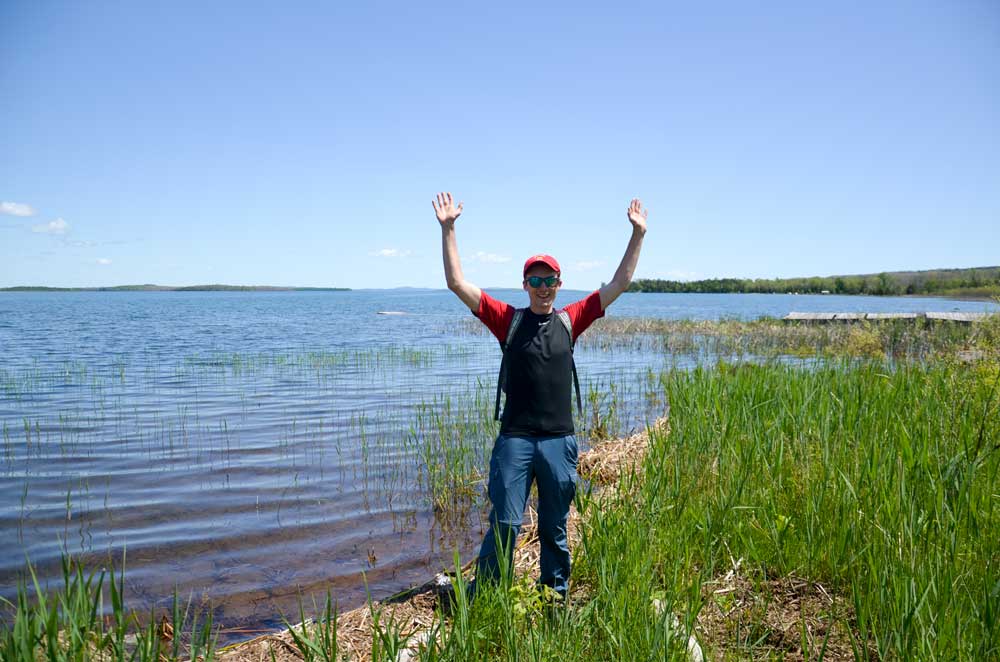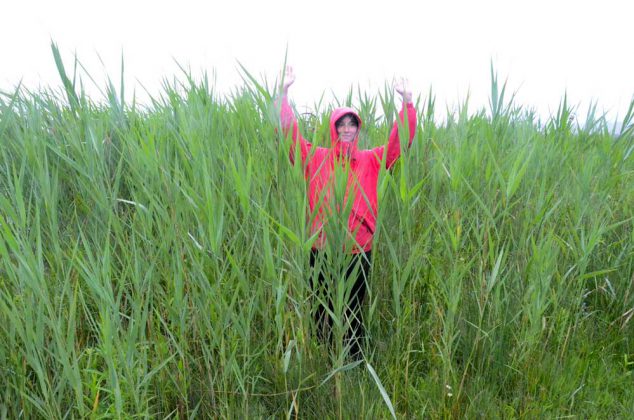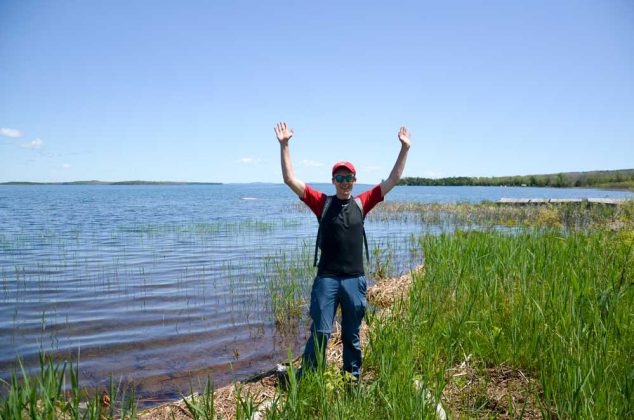MANITOULIN—What a difference a year makes, especially when coupled with the determined efforts of the staff and volunteers of the Manitoulin Phragmites Project. A recent survey of the beach at the Sheguiandah First Nation powwow grounds shows a startling reduction in the stands of the invasive reed that had basically overwhelmed the beach last year.
The battle isn’t over yet, as phragmites still has a beachhead in the water and shoreline, but last year’s efforts have reduced the stands by more than 75 percent.
“Drowning is effective,” said project manager biologist Judith Jones of Winter Spider Eco-consulting. “The stuff on land is tricky, phragmites has a formidable root.”
The results from last year’s efforts are impressive. “There are 27 sites with species at risk now under control; 13 sites outside species at risk habitat are now under control, that’s 40 sites that worked,” said Ms. Jones. “This is a big success. Thank you to everyone who reported phrag to us, volunteered on control and spread the word. A big thank you to the 2017 Manitoulin Project team of Rad M’Roz, Matthew Scott and Sally Robbins.”
In a letter to Tehkummah council, Ms. Jones explained the project’s approach when it comes to chemical controls. “One of the challenges the project faces in clearing the area is that herbicide spraying is not possible that close to the water, or over water. The Manitoulin Phragmites Project prefers to avoid the use of herbicides as much as possible—but on land herbicide is the most effective antidote available.”
“We do use herbicides, but only when nothing else works. It becomes a question of the least of all evils,” noted Ms. Jones when discussing this year’s plans. “If the damage caused by the herbicide is less than the damage being done by phragmites to the local ecology then sometimes it is the only available option.”
Even when herbicide is utilized, it is not applied in a general or random manner. The application is judiciously done by hand, using a spray pack and mitten. Ms. Jones has taken the relevant courses and is licenced to apply the plant control.
“The use of herbicide is not our first choice course of action. We spend most of the summer working on phragmites by cutting, digging, taking off seed heads, etc,” she wrote. “We have very good success getting rid of phrag when the plants are in water—if stems are cut well under the water, the lack of oxygen drowns the roots. However, when phragmites are on dry land, the only way to keep phrag from spreading and destroying natural habitat is to use herbicide. Cutting, mowing, bulldozing, even excavating, do not harm it. (In fact such approaches can actually do more harm than good as the plant can grow from tiny pieces of the main plant.) Thus, we have to weigh the cautious use of a small amount of herbicide versus the potential for a total loss of beach and shoreline. The mouth of Blue Jay Creek is one of several Manitoulin examples where loss like this is quickly happening. Fortunately, most of the area can be controlled with cutting in water, and very little herbicide use is necessary.”
Ms. Jones and her four-person crew, Matthew Scott and Sheila Madahbee (soon to be joined by one other crew member) have their work cut out for them this summer, but the results from last year’s efforts are highly encouraging. Currently, Ms. Jones and her crew members are on a three-day assessment tour of the Island. “We are seeing really, really good results,” said Ms. Jones. “Even better than we expected,” added Mr. Scott.
While the battle to keep phragmites at bay might seem at first blush to be hopeless, Ms. Jones and her crew are demonstrating that, with concerted and united effort, it is anything but hopeless—phragmites can be beaten. But the reed is pervasive and pernicious.
“Back in 2011 we surveyed the Island and we found a couple of plots,” noted Ms. Jones. By 2016 when the Manitoulin Phragmites Project got underway many of the Island’s shorelines had been overcome.
For those who are not yet aware, phragmites (frag-MITE-eez) is “an aggressive foreign grass that is rapidly spreading on shores and in wetlands. It grows in shallow water and damp sand or soil. It is wiping out fish spawning habitat, turtle nesting areas, and damaging beaches where people swim.”
People are the main cause of the spread of the invasive species, so education plays an important role in preventing its dispersal. Phragmites mainly spreads by pieces of plant that get stuck to ATVs and machinery. The pieces then fall off later at random places. “Please take a brush or a broom or a garden hose and clean off the underside of your machine each day before you set out,” advises a Manitoulin Phragmites Project plea to hunters and others travelling in the bush. “If any pieces of this plant fall off in your driveway or at your camp, it is very unlikely they will grow. If they do, you will see it and can take care of it. Don’t drive through patches of phragmites.”
It is important to note that it isn’t just boats, ATVs and four-wheel drive vehicles that have to be monitored. Even cyclists can inadvertently spread the reed, so don’t cycle through patches either.
If you have harvested a patch of phragmites, be sure to burn it after letting it dry thoroughly.
If you spot a patch of phragmites on or near your property you wish help in controlling, please report its location to manitoulinphrag@yahoo.ca. There will be plenty of opportunities to lend a hand as the group plans to once again hold Pragmites Week and are actively looking for barges or snub-nosed boats to assist with the in-water efforts.






